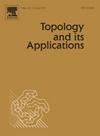轨迹混沌
IF 0.5
4区 数学
Q3 MATHEMATICS
引用次数: 0
摘要
设f是紧度量空间X的连续自映射,设O(f)是f下所有轨迹的集合,设T表示它在具有Hausdorff度规的X的所有非空封闭子集的超空间K(X)中的闭包。映射f以一种自然的方式在空间T上诱导出一个自映射f¯。本文研究了诱导系统(T,f¯)的传递性、灵敏度和混沌性。虽然我们证明了后一种系统永远不可能是Devaney混沌,但我们提供了一个系统(X,f)的例子,其相关的诱导系统(T,f¯)是敏感的。我们研究了基本系统(X,f)和它的诱导系统(T,f¯)之间的哪些性质是继承的。我们证明了在超空间上的一些已知结果在轨迹空间上不成立。本文章由计算机程序翻译,如有差异,请以英文原文为准。
Chaos of trajectories
Let f be a continuous self-map of a compact metric space X. Let be the set of all trajectories under f, and let T denote its closure in the hyperspace of all nonempty closed subsets of X equipped with the Hausdorff metric. The map f induces in a natural way a self-map on the space T. In this paper, we study transitivity, sensitivity, and chaos for the induced system . While we prove that this latter system can never be Devaney chaotic, we provide an example of a system for which the associated induced system is sensitive. We study which properties are inherited between the base system and its induced system . We prove that several known results on the hyperspaces fail to be true on the spaces of trajectories.
求助全文
通过发布文献求助,成功后即可免费获取论文全文。
去求助
来源期刊
CiteScore
1.20
自引率
33.30%
发文量
251
审稿时长
6 months
期刊介绍:
Topology and its Applications is primarily concerned with publishing original research papers of moderate length. However, a limited number of carefully selected survey or expository papers are also included. The mathematical focus of the journal is that suggested by the title: Research in Topology. It is felt that it is inadvisable to attempt a definitive description of topology as understood for this journal. Certainly the subject includes the algebraic, general, geometric, and set-theoretic facets of topology as well as areas of interactions between topology and other mathematical disciplines, e.g. topological algebra, topological dynamics, functional analysis, category theory. Since the roles of various aspects of topology continue to change, the non-specific delineation of topics serves to reflect the current state of research in topology.
At regular intervals, the journal publishes a section entitled Open Problems in Topology, edited by J. van Mill and G.M. Reed. This is a status report on the 1100 problems listed in the book of the same name published by North-Holland in 1990, edited by van Mill and Reed.

 求助内容:
求助内容: 应助结果提醒方式:
应助结果提醒方式:


